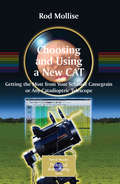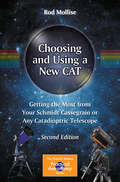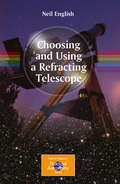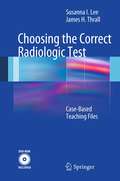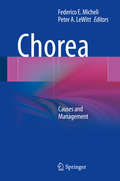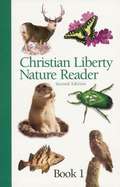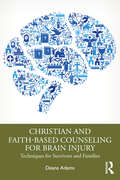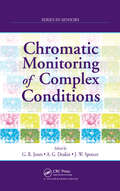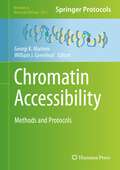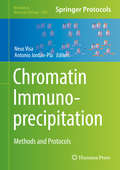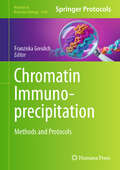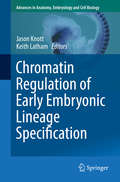- Table View
- List View
Choosing and Using a New CAT: Getting the Most from Your Schmidt Cassegrain or Any Catadioptric Telescope (The Patrick Moore Practical Astronomy Series)
by Rod MolliseChoosing and Using the New CAT will supersede the author's successful Choosing and Using a Schmidt-Cassegrain Telescope, which has enjoyed enthusiastic support from the amateur astronomy community for the past seven years. Since the first book was published, a lot has changed in the technology of amateur astronomy. The sophistication and variety of the telescopes available to amateurs has increased dramatically. Computerized SCTs, Maksutov-Cassegrains, and most recently Meade's new and acclaimed Ritchey-Chrétiens have come to dominate the market. That means that all amateurs considering the purchase of a new telescope (not only a SCT, and not just beginners) will benefit from this detailed guide. Choosing the right telescope for particular kinds of observation (or even for general work) is far from easy - but Rod Mollise gives invaluable advice and guidance.
Choosing and Using a New CAT: Getting the Most from Your Schmidt Cassegrain or Any Catadioptric Telescope (The Patrick Moore Practical Astronomy Series)
by Rod MolliseCatadioptric telescopes (CATs) such as the Schmidt Cassegrains remain popular among amateur astronomers for their ability to reveal thousands of beautiful deep-space wonders. Additionally, their computer-assisted capabilities allow them to automatically point to and track celestial objects, making astronomy accessible to more people than ever before. However, selecting the right one and learning how to use it can be difficult for stargazers both old and new. That’s where this book comes in. The first edition, published in 2009, has remained the standard reference for mastering these popular instruments. This revised edition brings the material completely up to date, with several extensively rewritten chapters covering the most recent developments in telescope and camera equipment as well as computer software.Through the author’s 45 years of experience with catadioptric telescopes, readers will learn to decide which catadioptric telescope is right for them, to choose a specific make and model, and finally, to use the telescope in the field. Covered in other chapters are: Solar System and deep-sky observations; astrophotography and computer control of CATs; and troubleshooting and maintaining your equipment.If you dream of owning a telescope or are frustrated by the telescope you already own, this is the book for you!
Choosing and Using a Refracting Telescope (The Patrick Moore Practical Astronomy Series)
by Neil EnglishChoosing and Using a Refracting Telescope has been written for the many amateur astronomers who already own, or are intending to purchase, a refracting telescope - perhaps to complement their existing arsenal of larger reflecting telescopes - or for the specialist who requires a particular refractor for serious astronomical applications or nature studies. Four hundred year ago, during the winter of 1609, a relatively unknown Italian scientist, Galileo Galilei designed a spyglass with two crude lenses and turned it skyward. Since then, refractors have retained their dominance over all types of reflector in studies of the Moon, planets and double stars because of the precision of their optics and lack of a central obstruction in the optical path, which causes diffraction effects in all commercially-made reflectors. Most mature amateur astronomers got started with a 60mm refractor, or something similar. Thirty years ago, there was little choice available to the hobbyist, but in the last decade long focus crown-flint achromats have moved aside for some exquisitely crafted apochromatic designs offered by leading commercial manufacturers. There has been a huge increase in the popularity of these telescopes in the last few years, led by a significant increase in the number of companies (particularly, William Optics, Orion USA, StellarVue, SkyWatcher and AstroTech) who are now heavily marketing refractors in the amateur astronomical magazines. In Choosing and Using a Refracting Telescope, well-known observer and astronomy writer Neil English celebrates the remarkable history and evolution of the refracting telescope and looks in detail at the instruments, their development and their use. A major feature of this book is the way it compares not only different classes of refractor, but also telescopes of each class that are sold by various commercial manufacturers. The author is perhaps uniquely placed to do this, having used and tested literally hundreds of different refracting telescopes over three decades. Because it includes many diverse subjects such as imaging with consumer-level digital cameras, imaging with webcams, and imaging with astronomical CCD cameras - that are not covered together in equal depth in any other single volume - Choosing and Using a Refracting Telescope could become the 'refractor bible' for amateur astronomers at all levels, especially those who are interested in imaging astronomical objects of every class.
Choosing the Correct Radiologic Test: Case-Based Teaching Files
by James H. Thrall Susanna LeeOwing to financial constraints, greater pressure is being put on physicians to order only appropriate radiologic exams. The American College of Radiology (ACR) Appropriateness Criteria have emerged as a widely accepted standard by which the appropriate use of radiologic exams is judged. This book enables physicians and trainees to learn the ACR recommendations in a clinically relevant and intellectually stimulating way. More than 400 clinical scenarios are organized into ten modules based on organ systems. Each scenario is addressed by means of an interactive quiz in which the reader is invited to select the best option from various imaging modalities. Each choice is given a numerical rating of appropriateness, with accompanying comments when necessary. Correlative images of pathologies are included to enhance the reader's appreciation of the diagnostic power of the modality in question. This book is ideal as a tool both for self-study and for quantitative evaluation of students' knowledge.
Chorea: Causes and Management
by Federico E. Micheli Peter A. LewittChorea: Causes and Management provides a comprehensive and timely update for the wide variety of neurological conditions, both inherited and acquired, which result in this common hyperkinetic movement disorder. This book describes in detail the latest clinical and etiological information regarding chorea. Management strategies, pathophysiology, and associated medical and psychiatric problems associated with chorea are also addressed. The nineteen chapters are contributed by internationally-recognized authors working at the forefront of research in the specific disorders linked to chorea. Chorea: Causes and Management is aimed at an audience of neurologists, psychiatrists, neuropsychologists, specialists in medical genetics, clinical and basic researchers in neurosciences, and generalist clinical physicians with an interest in movement disorders.
Christ and the Created Order: Perspectives from Theology, Philosophy, and Science
by Thomas H. McCall Andrew B. TorranceAccording to the Christian faith, Jesus Christ is the ultimate revelation not only of the nature of God the Creator but also of how God the Creator relates to the created order. The New Testament explicitly relates the act of creation to the person of Jesus Christ - who is also a participant within creation, and who is said, by his acts of participation, to have secured creation's ultimate redemption from the problems which presently afflict it. Christian theology proposes that Jesus Christ, the incarnate Word and Wisdom of God, the agent in whom the Spirit of God is supremely present among us, is the rationale and the telos of all things - time-space as we experience and explore it; nature and all its enigmas; matter itself. Christology is thus utterly fundamental to a theology of creation, as this is unfolded both in Scripture and in early Christian theology.For all this, the contemporary conversation about science and faith tends, to a remarkable degree, to neglect the significance of Jesus Christ, focusing instead on a generic "God of wonder" or "God of natural theology." Such general theism is problematic from the perspective of Christian theology on many levels and has at times led to a more or less deistic theology: the impression that God has created the world, then largely left it to itself. Such a theology is far removed from classical Christian renderings of creation, providence, redemption, and eschatology. According to these, the theology of creation is not just about remote "beginnings," or the distant acts of a divine originator. Rather, the incarnate Jesus Christ is himself - remarkably - the means and the end for which creation itself exists. If we would think aright about our world, study it and live within it wisely, we must reckon centrally with his significance.What might such a bold claim possibly mean, and why is Jesus Christ said by Christian theology to be so important for understanding God's overall relationship to the created order? What does this importance mean for science?Christ and the Created Order addresses these questions by gathering insights from biblical scholars, theologians, historians, philosophers, and scientists. This interdisciplinary collection of essays reflects on the significance of Jesus Christ for understanding the created world, particularly as that world is observed by the natural sciences.Contributors to Christ and the Created Order include Marilyn McCord Adams, Richard Bauckham, Deborah Haarsma, Paul Moser, Murray Rae, James K. A. Smith, Norman Wirzba, N. T. Wright, and more.
Christ the Answer
by Father SullivanFather Peter Sullivan in Christ the Answer presents a Catholic apologetic for why Jesus Christ is the answer for people in the modern world. He begins his discussion by explaining the philosophical, scientific, rational and ontological reasons for the existence of God. After this, he explains why Christ is God by exploring the truth of the gospels and the veracity of the gospel writers. In his exegesis, he discusses the unique qualities of Christ, His own revelation of His divinity and the nature of His death and resurrection. These points further point to Christ's divinity. Sullivan's ends his discussion by presenting reasons why belief in Christ and following His teachings will help to solve humankind's existential crisis and moral decay. In support of this premise, he discusses the modern day occurrences in Fatima and Lourdes. This book examines the reasons for unbelief and provides rational explanations. His extensive footnotes and references substantiate his points and provide readers with ways to get additional information. Even though this work is scholastic, it is written in a straightforward manner so that non-academic readers are able to understand the material. In addition, he gives study outlines and summaries for each chapter to help readers better navigate the content. For more sophisticated readers, the work ends with two appendixes on science and God. Even though this book is written by a Catholic, much of its content is of interest and of value to non-Catholic readers as well.
Christian Delusion: Why Faith Fails
by John W. LoftusIn this anthology of recent criticisms aimed at the reasonableness of Christian belief, a former evangelical minister and apologist, author of the critically acclaimed Why I Became an Atheist, has assembled fifteen outstanding articles by leading skeptics, expanding on themes introduced in his first book. Central is a defense of his "outsider test of faith," arguing that believers should test their faith with the same skeptical standards they use to evaluate the other faiths they reject, as if they were outsiders. Experts in medicine, psychology, and anthropology join Loftus to show why, when this test is applied to Christianity, it becomes very difficult to rationally defend. Collectively, these articles reveal that popular Christian beliefs tend to rely on ignorance of the facts. Drawing together experts in diverse fields, including Hector Avalos, Richard Carrier, David Eller, and Robert Price, this book deals a powerful blow against Christian faith.
Christian Liberty Nature Reader: Book One
by Wendy Kramer Florence BassThis colorful reader will introduce students to God's marvelous creation and reinforce phonics principles. Students will also learn beginning vocabulary skills as he is exposed to new words. A glossary of terms is also provided at the end. (Christian Liberty Press) Grade: 1st
Christian Science on Trial: Religious Healing in America (Medicine, Science, and Religion in Historical Context)
by Rennie B. SchoepflinIn Christian Science on Trial, historian Rennie B. Schoepflin shows how Christian Science healing became a viable alternative to medicine at the end of the nineteenth century. Christian Scientists did not simply evangelize for their religious beliefs; they engaged in a healing business that offered a therapeutic alternative to many patients for whom medicine had proven unsatisfactory. Tracing the evolution of Christian Science during the late nineteenth and early twentieth centuries, Christian Science on Trial illuminates the movement's struggle for existence against the efforts of organized American medicine to curtail its activities.Physicians exhibited an anxiety and tenacity to trivialize and control Christian Scientists which indicates a lack of confidence among the turn-of-the-century medical profession about who controlled American health care. The limited authority of the medical community becomes even clearer through Schoepflin's examination of the pitched battles fought by physicians and Christian Scientists in America's courtrooms and legislative halls over the legality of Christian Science healing. While the issues of medical licensing, the meaning of medical practice, and the supposed right of Americans to therapeutic choice dominated early debates, later confrontations saw the legal issues shift to matters of contagious disease, public safety, and children's rights. Throughout, Christian Scientists revealed their ambiguous status as medical practitioners and religious healers. The 1920s witnessed an unsteady truce between American medicine and Christian Science. The ambivalence of many Americans about the practice of religious healing persisted, however. In Christian Science on Trial we gain a helpful historical context for understanding late–twentieth-century public debates over children's rights, parental responsibility, and the authority of modern medicine.
Christian and Faith-based Counseling for Brain Injury: Techniques for Survivors and Families
by Deana AdamsChristian and Faith-based Counseling for Brain Injury is the first book of its kind to offer faith-based therapy to address the emotional, cognitive, and mental health needs of individuals who have suffered a traumatic brain injury (TBI). A highly researched piece of work, the book puts forth an innovative and effective method for not only addressing the challenges of a life-changing injury but also for creating a sense of purpose. Through the nuances of faith-based counselling, this book focuses on the spiritual and existential aspects of understanding the diagnosis and creating a purpose post-injury. It examines how brain injury can affect an individual by exploring the deficits of brain injury, the impact of brain injury, and the challenges specific to damage to certain brain lobes. It also describes the mental health issues, such as depression, anxiety, grief, anger, and posttraumatic stress, that can affect both the survivor and their family members. Offering targeted counseling techniques and adaptive strategies, it shows how faith-based counselors can effectively treat brain injury. This book is valuable reading for all individuals invested in providing support to the TBI community. It is aimed at counselors, lay counselors, healthcare professionals, social workers, psychotherapists, seminary students, and upper-level graduate students. It will further be of use to for clinicians working in the outpatient level of care and private practice settings.
Christianity and Evolution: Reflections on Science and Religion
by Pierre Teilhard de ChardinThe author of The Phenomenon of Man reconciles passionate faith with the rigor of scientific thinking. With his unique background as a geologist, paleontologist, and Jesuit priest, Pierre Teilhard de Chardin was a powerful exponent of the view that scientific theories could comfortably coexist with religious faith. To this day, his ideas provoke passionate debates in communities that view science and faith as necessarily separate ideologies. In this collection of nineteen essays, Teilhard seeks to illuminate a middle ground between science and religion that he felt both disciplines could accept. He explores the Fall and original sin, the possibility of life on other planets, and the role that God may have played in the process of human evolution, successfully challenging contemporary theologians to rethink their views of the universe and its creation. &“Like other great visionary poets—Blake, Hopkins, Yeats—Teilhard engages the reader both intellectually and sensually.&” —The Washington Post Book World &“An excellent blend of theological speculation with practical or ascetical application.&” —Catholic Telegraph
Christianity in the Light of Science: Critically Examining the World's Largest Religion
by John W. LoftusThis anthology of new critical essays written by experts in their fields, in honor of the late Victor Stenger, examines Christianity using established scientific criteria. Where science specifically touches upon the claims of Christianity the authors seek to show those claims lack the required evidence. The result is that Christianity is not a sufficiently evidenced religion. In his New York Times bestseller, God: The Failed Hypothesis, physicist Victor Stenger argued that claims of religion should be subject to the same standards of scientific rigor as any other truth claim. Taking this approach, the contributors argue that Christianity fails every known scientific test for truth. Stenger himself wrote a chapter for this volume before he died.In it he presents a brief history of ideas about cosmology, showing that Christianity's premodern understanding of the cosmos is incompatible with current scientific evidence regarding the origin and structure of the cosmos. Other contributors examine a wide variety of topics, including biblical archaeology, Intelligent Design, the Shroud of Turin, free will, the existence of the soul, the efficacy of petitionary prayer, and more. This challenging work is indispensable reading for both skeptical readers and open-minded people of faith.
Christo-Fiction
by Robin Mackay François LaruelleFrançois Laruelle's lifelong project of "nonphilosophy," or "nonstandard philosophy," thinks past the theoretical limits of Western philosophy to realize new relations among religion, science, politics, and art. In Christo-Fiction, Laruelle targets the rigid, self-sustaining arguments of metaphysics, rooted in Judaic and Greek thought, and the radical potential of Christ, whose "crossing" disrupts their circular discourse. Laruelle's Christ is not the authoritative figure conjured by academic theology, the Apostles, or the Catholic Church. He is the embodiment of generic man, founder of a science of humans, and the herald of a gnostic messianism that calls forth an immanent faith. Explicitly inserting quantum science into religion, Laruelle recasts the temporality of the cross, the entombment, and the resurrection, arguing that it is God who is sacrificed on the cross so that equals in faith may be born. Positioning itself against orthodox religion and naive atheism alike, Christo-Fiction is a daring, heretical experiment that ties religion tightly to the human experience and the lived world.
Christo-Fiction: The Ruins of Athens and Jerusalem (Insurrections: Critical Studies in Religion, Politics, and Culture)
by François LaruelleFrançois Laruelle's lifelong project of "nonphilosophy," or "nonstandard philosophy," thinks past the theoretical limits of Western philosophy to realize new relations between religion, science, politics, and art. In Christo-Fiction Laruelle targets the rigid, self-sustaining arguments of metaphysics, rooted in Judaic and Greek thought, and the radical potential of Christ, whose "crossing" disrupts their circular discourse. Laruelle's Christ is not the authoritative figure conjured by academic theology, the Apostles, or the Catholic Church. He is the embodiment of generic man, founder of a science of humans, and the herald of a gnostic messianism that calls forth an immanent faith. Explicitly inserting quantum science into religion, Laruelle recasts the temporality of the cross, the entombment, and the resurrection, arguing that it is God who is sacrificed on the cross so equals in faith may be born. Positioning itself against orthodox religion and naive atheism alike, Christo-Fiction is a daring, heretical experiment that ties religion to the human experience and the lived world.
Chromaffin Cells: Methods and Protocols (Methods in Molecular Biology #2565)
by Ricardo BorgesThis volume covers the most up-to-date methods and techniques used to further the understanding of chromaffin cell biology and pharmacology. Chapters guide readers through the basic mechanisms that regulate the stimulus-secretion coupling, chromaffin, tumor-derived cell PC-12 , morphology, biochemistry, pharmacology, electrophysiology, and electrochemistry. Written in the successful Methods in Molecular Biology series format, chapters include introductions to their respective topics, lists of the necessary materials and reagents, step-by-step, readily reproducible protocols, and notes on troubleshooting and avoiding known pitfalls. Authoritative and cutting-edge, Chromaffin Cells: Methods and Protocols aims to be a useful practical guide to researches to help further their study in this field.
Chromatic Monitoring of Complex Conditions (Series in Sensors)
by Joseph W. Spencer Gordon Rees Jones Anthony G. DeakinExplaining the chromatic methodology for the intelligent monitoring of complex systems, Chromatic Monitoring of Complex Conditions demonstrates that chromatic processing is analogous to human vision yet also extends into a wide range of nonoptical domains.Taking a practical approach that utilizes many examples and graphs, the book presen
Chromatin Accessibility: Methods and Protocols (Methods in Molecular Biology #2611)
by Georgi K. Marinov William J. GreenleafThis detailed volume provides a comprehensive resource covering the existing and state-of-the-art tools in the field of profiling chromatin accessibility and its dynamics. Beginning with a section on bulk-cell methods for profiling chromatin accessibility and nucleosome positioning that rely on enzymatic cleavage of accessible DNA and produce information about relative accessibility, the book continues with methods that use single-molecule and enzymatic approaches to solving the problem of mapping absolute occupancy/accessibility, emerging tools for mapping DNA accessibility and nucleosome positioning in single cells, imaging-based methods for visualizing accessible chromatin in its nuclear context, as well as computational methods for the processing and analysis of chromatin accessibility datasets. Written for the highly successful Methods in Molecular Biology series, chapters include introductions to their respective topics, lists of the necessary materials and reagents, step-by-step and readily reproducible laboratory protocols, and tips on troubleshooting and avoiding known pitfalls. Authoritative and up-to-date, Chromatin Accessibility: Methods and Protocols serves as an extensive and useful reference for researchers studying different facets of chromatin accessibility in a wide variety of biological contexts. Chapter 6 is available open access under a Creative Commons Attribution 4.0 International License via link.springer.com.
Chromatin Architecture: Advances From High-resolution Single Molecule DNA Imaging (Springer Theses)
by Kirti PrakashThis book sheds new light on the current state of knowledge concerning chromatin organization. Particular emphasis is given to the new imaging potential offered by super-resolution microscopy, which allows DNA imaging with a very high labeling density. From the early work on chromosomes by Walther Flemming in the nineteenth century to recent advances in genomics, the history of chromatin research now spans more than a century. The various milestones, such as the discovery of the double helix structure, the sequencing of the human genome, and the recent description of the genome in 3D space, show that understanding chromatin and chromosome function requires a clear understanding of its structure. Presenting cutting-edge data from super-resolution single molecule microscopy, the book demonstrates that chromatin manifests several levels of folding, from nucleosomes to chromosomes. Chromatin domains emerge as a new fundamental building block of chromatin architecture, with functions possibly related to gene regulation. A detailed description of chromatin folding in the pachytene stage of meiosis serves as a model for exploring this functionality, showing the apparent interplay between structure, function, and epigenetic regulation. Lastly, the book discusses possible new avenues of innovation to describe chromatin's organization and functions. Gathering essential insights on chromatin architecture, the book offers students an introduction to microscopy and its application to chromatin organization, while also providing advanced readers with new ideas for future research.
Chromatin Immunoprecipitation: Methods and Protocols (Methods in Molecular Biology #1689)
by Neus Visa Antonio Jordán-PlaThis up-to-date volume includes protocols that illustrate the broad use of chromatin immunoprecipitation (ChIP) and ChIP-related methods in a variety of biological research areas. The collection also includes protocols designed to improve the performance of ChIP for specific applications. Written in the highly successful Methods in Molecular Biology series format, chapters include introduction to their respective topics, lists of the necessary materials and reagents, step-by-step, readily reproducible laboratory protocols, as well as tips on troubleshooting and avoiding known pitfalls. Authoritative and practical, Chromatin Immunoprecipitation: Methods and Protocols features techniques, including bioinformatic analysis of ChIP data, will be of interest to a very broad research community in the fields of biochemistry, molecular biology, microbiology, and biomedicine.
Chromatin Immunoprecipitation: Methods and Protocols (Methods in Molecular Biology #2846)
by Franziska GreulichThis comprehensive guide delves into the protocols and strategies for investigating gene regulation both experimentally and computationally. It focuses on the use of Chromatin Immunoprecipitation (ChIP) coupled with next-generation sequencing, providing a robust framework for profiling DNA-binding proteins, examining DNA footprinting, and analyzing histone modifications. As part of the highly successful Methods in Molecular Biology series, this book offers introductions on the topics covered, detailed lists of the necessary materials and reagents, step-by-step laboratory protocols that are easy to follow, and expert tips for troubleshooting and avoiding known pitfalls. Authoritative and practical, Chromatin Immunoprecipitation: Methods and Protocols is the perfect resource for the new wave of genome biologists looking to master ChIP techniques.
Chromatin Protocols (Methods in Molecular Biology #119)
by Peter B. BeckerThe state-of-the-art methods collected here are designed to analyze the relationship between chromatin structure and function, and to elucidate the molecular mechanisms that control such vital cellular functions as transcription, replication, recombination, and DNA repair. These proven methods cover a wide range of topics, from powerful cell-free systems for the reconstitution of chromatin heterogeneity in vitro, to both classical and cutting-edge techniques for in vivo analysis of protein-DNA interactions. Each method includes detailed step-by-step instructions to ensure successful replication along with helpful notes about how to avoid pitfalls. All authors are leading scientists, well known for their methodological expertise in the chromatin research.
Chromatin Protocols (Methods in Molecular Biology #1288)
by Srikumar P. ChellappanSignificant advancements have been made in the study of chromatin structure and function over the past fifty years but none as spectacular as those made in the last decade due to the development of novel techniques and the ability to sequence large stretches of DNA. In Chromatin Protocols, Second Edition, expert researchers delineate these cutting-edge techniques via step-by-step laboratory methods and protocols, which encompass a wide array of topics from the isolation of nucleosomes, assembly of nucleosomes and study of the basic chromatin structure to detailed analysis of histone modifications and chromatin function. Written in the highly successful Methods in Molecular BiologyTM series style, chapters include brief introductions to the subjects, lists of the necessary materials and reagents, readily reproducible protocols, and Notes sections which highlight tips on troubleshooting and avoiding known pitfalls. Comprehensive and up-to-date, Chromatin Protocols, Second Edition is a valuable tool for scientists studying various aspects of chromatin function and an ideal guide to aid in the development of new techniques as well as new ideas in the field of chromatin biology.
Chromatin Regulation of Early Embryonic Lineage Specification (Advances in Anatomy, Embryology and Cell Biology #229)
by Jason Knott Keith LathamFive leaders in the field of mammalian preimplantation embryo development provide their own perspectives on key molecular and cellular processes that mediate lineage formation during the first week of life. The first cell-fate decision involves the formation of the pluripotent inner cell mass (ICM) and extraembryonic trophectoderm (TE). The second cell-fate choice encompasses the transformation of ICM into extraembryonic primitive endoderm (PE) and pluripotent epiblast. The processes, which occur during the period of preimplantation development, serve as the foundation for subsequent developmental events such as implantation, placentation, and gastrulation. The mechanisms that regulate them are complex and involve many different factors operating spatially and temporally over several days to modulate embryonic chromatin structure, impose cellular polarity, and direct distinct gene expression programs in the first cell lineages.
Chromatin: Methods and Protocols (Methods in Molecular Biology #2458)
by Julia Horsfield Judith MarsmanThis volume provides cutting-edge techniques to further the study chromatin biology. Chapters include both novel and well-established methods for the analysis of DNA-associated proteins, DNA methylation, three-dimensional chromatin interactions, deep sequencing-based tools, and data analysis pipelines. Written in the format of the highly successful Methods in Molecular Biology series, each chapter includes an introduction to the topic, provides details of the necessary materials and reagents, includes tips on troubleshooting and known pitfalls, and describes step-by-step, readily reproducible protocols. Authoritative and cutting-edge, Chromatin: Methods and Protocols aims to further the understanding of how modified DNA and associated proteins affect the transcriptional output of the genome.Chapter Genome-wide mapping and microscopy visualization of protein-DNA interactions by pA-DamID [Chapter 12] is available open access under a Creative Commons Attribution 4.0 International License via link.springer.com.
